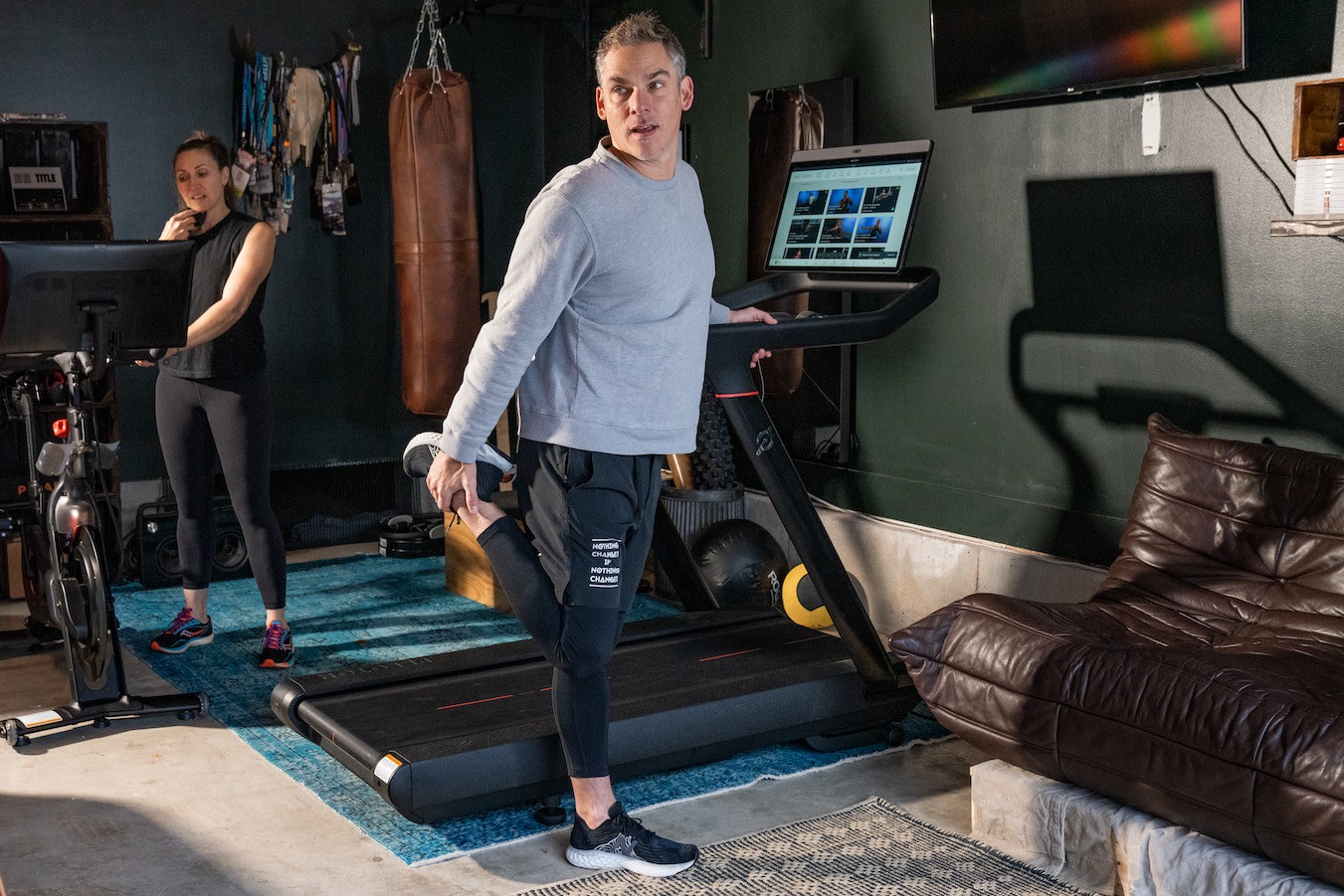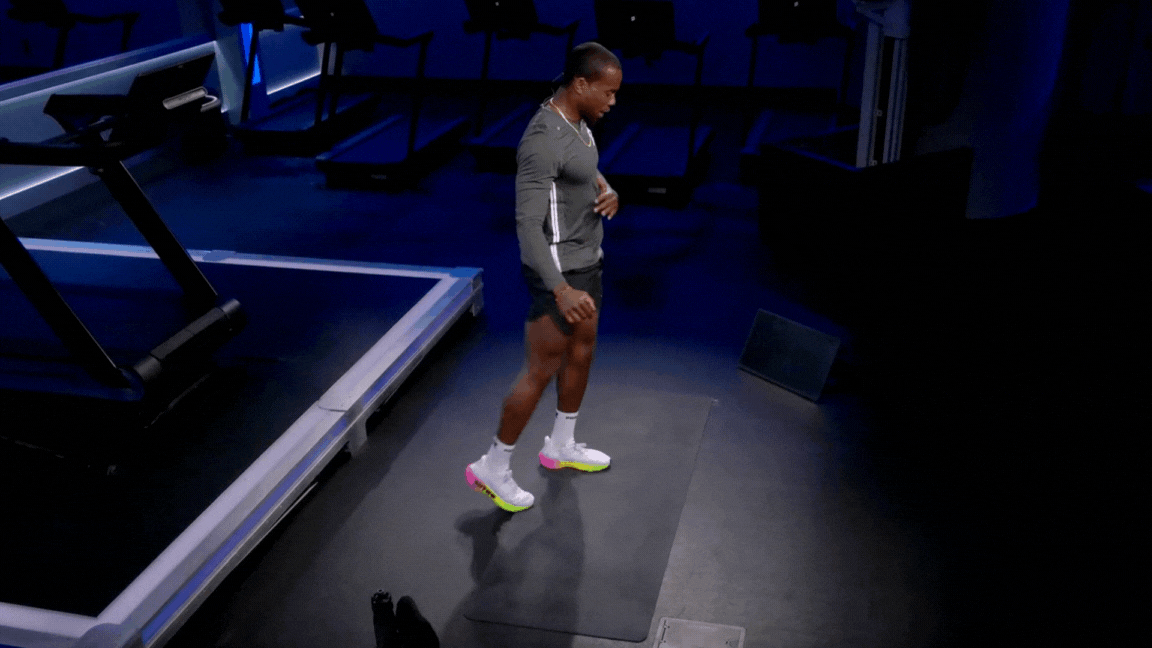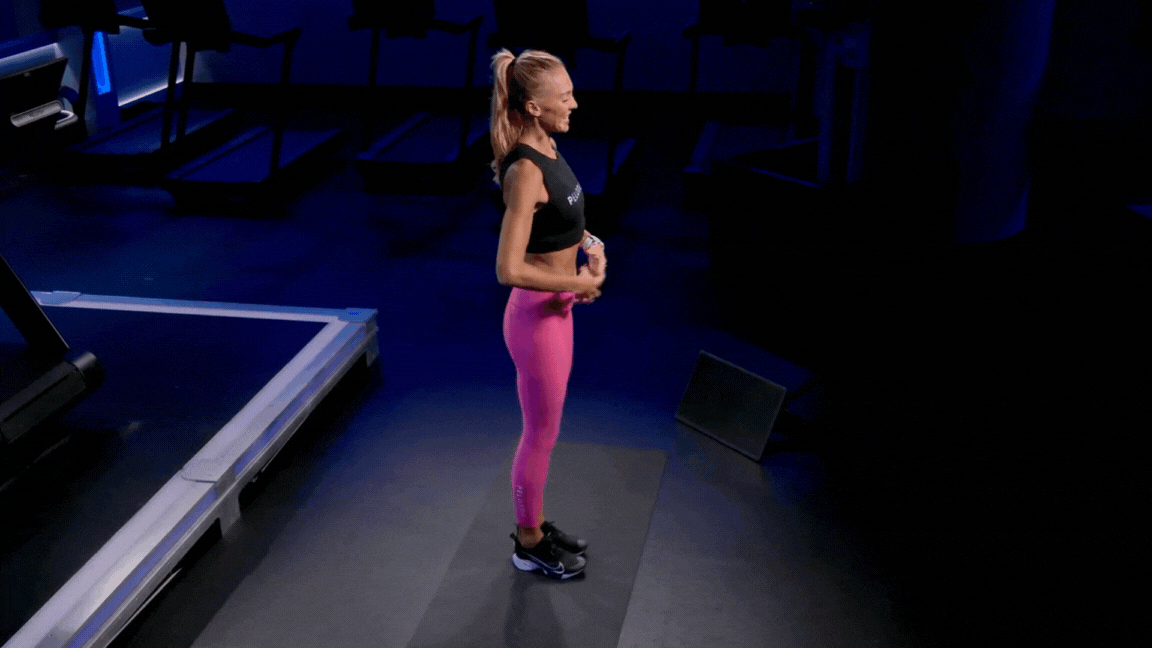
These 9 Stretches Will Help You Get the Most Out of Your Next Treadmill Workout
Not sure which moves to do, or how long to hold them? Here, we break down all of your pre-run stretching questions.
By Team Peloton•
Dynamic vs. Static Stretching
Benefits of Stretching Before a Run
Essential Stretches Before Treadmill Running
How to Integrate Stretches Into Your Workout Routine
How to Customize Your Stretching Plan
Common Stretching Mistakes to Avoid
Frequently Asked Questions
The Takeaway
If you’ve ever warmed up for a treadmill workout by walking for a few minutes (or skipped your warm-up entirely), you’re certainly not alone. But stretching before a treadmill workout is essential—regardless of how fast you plan to walk, jog, or run.
For starters, stretching prepares your muscles and joints for physical activity, but it also improves flexibility, increases your range of motion, and reduces the risk for some injuries—all benefits that can boost your performance.
So, which stretches should you do before your next treadmill workout? And how long should you hold them? Below, we’ll cover the importance of stretching before treadmill runs and provide step-by-step instructions on how to do Peloton instructor-approved stretches.
Dynamic vs. Static Stretching
Before you come up with your pre-treadmill stretching plan, you should be well-versed in the difference between static and dynamic stretching.
While doing static stretching, you hold one position for 15 to 45 seconds (depending on what feels good for your body). Some classic examples are grabbing your foot for a quad stretch, touching your toes, or pulling your arm across your chest.
On the other hand, dynamic stretching involves controlled movements that increase the targeted muscle group’s range of motion. The goal of dynamic stretching is to warm up your muscles through movement (think: walking lunges, squats, or butt kicks).
You can perform dynamic stretches for a specific period of time (typically between 30 seconds and one minute), or you can count repetitions. It's all about doing what feels right for you and your body.
In short, the primary difference between static and dynamic stretching is that the latter requires gentle, controlled movement, and the former does not. If you’re searching for stretches to do before running or walking on a treadmill, dynamic stretches are preferable.
“Static stretching should never be used before or during a workout because it will actually decrease your body's ability to create force,” Peloton instructor Hannah Corbin previously told The Output. “Dynamic stretching, on the other hand, is a form of mobilization, so it is a great option for a pre-workout to get your body ready to perform.” As an added bonus, dynamic stretching can help you focus and get in the right mindset before a workout.
Benefits of Stretching Before a Run
So, why should you do dynamic stretches before running on a treadmill? For starters, they promote flexibility and provide a full body warm-up in 10 minutes or less, depending on which moves you choose. Many of these stretches also activate your core, improving stability and engaging your muscles. Below, learn more about the benefits of dynamic stretching before treadmill runs.
Increased Flexibility
Dynamic stretching can combat inflexibility and muscle weakness, which go hand in hand. A 2019 study published in the Journal of Sport Science & Medicine found that dynamic stretching increases range of motion and flexibility as well as decreases stiffness. So if you’re looking to improve your flexibility, dynamic stretches are a fantastic, low commitment way to start.
Better Performance
Because dynamic stretches increase flexibility and improve range of motion, they can improve your overall performance. Regardless of your exercise goals, these movements can help you with acceleration, speed, and agility.
More Body Awareness
Dynamic stretches often include the same (or very similar) movements that come up in workouts. For example, doing walking lunges ahead of a gym session not only gears your body up for reverse lunges with bicep curls, but it also familiarizes you with the movement.
Improved Agility
Looking for agility-focused dynamic stretches? There are plenty to choose from. Do high knees or side shuffles to get your feet and legs moving. After all, dynamic stretching prepares you for the patterns and movements you'll use during your workout.
Essential Stretches Before Treadmill Running
Ready to run? First, try these nine essential dynamic stretches. You might be surprised at how they impact your performance on the treadmill.

Front and Back Hurdles
Front and back hurdles will open your hips and activate your core.
Stand with your feet hip distance apart.
Lift your right leg, bending your knee at 90 degrees.
Open your right leg as far as possible to the right, as if you were jumping over a hurdle.
Bring your right leg back to the center before returning your foot to the ground.
Repeat on the other side.
Muscles worked: Hip flexors, core, glutes

Leg Swings
Swinging your legs front and back will increase circulation and loosen your hips. Start small and work your way up to bigger swings.
Stand on your left leg and swing your right leg back and forth, slowly increasing your range of motion.
Use the wall or a chair if you need balance assistance.
Switch sides.
Muscles worked: Quads, hamstrings, groin

Knee Hugs
Not only does this dynamic stretch feel great on your lower body, but it also increases your hip mobility.
Stand with your feet hip distance apart.
Pull your knee to your chest while holding your shin under your knee.
Hold the hug for one second, then repeat on the other side. Continue alternating legs.
Muscles worked: Glutes, lower back, hamstrings, quads

Dynamic Quad Stretch
This stretch improves balance and stability while activating your quads.
Stand on your right leg and use your left hand to hold your left foot, pulling it toward your glutes.
Hold the stretch for one second.
Repeat with your right leg and continue alternating legs.
Muscles worked: Quads
Table Tops
Table tops are perfect for building strength, improving stability, and loosening your glutes. Although they’re meant to be done on two feet, you can also move to all fours.
Stand with your feet hip distance apart.
Lift your left leg, keeping your knee bent at 90 degrees, and lift it to the side.
Place your hand on your left knee and gently push it down, keeping your back straight and your core tight.
Repeat on the other side.
Muscles worked: Glutes, quads
Reverse Lunge with Rotation
This dynamic stretch will loosen your lower body and improve your balance. You might find yourself wobbling as you rotate, and that’s completely okay. Squeeze your glutes and brace your core to maintain balance.
Stand with your feet hip distance apart.
Step back with your right foot and bend your right knee until your leg is at 90 degrees. Your knee should almost be touching the ground.
Rotate your torso toward your left knee.
Come back to the center, and bring your right leg forward to the starting position.
Alternate sides.
Muscles worked: Glutes, hip flexors, hamstrings, quads

Alternating Side Lunges
Now that you’ve mastered reverse lunges, it’s time to go side to side. These alternating side lunges increase mobility and loosen adductors, glutes, hamstrings, and quads.
Stand with your legs wider than your shoulders.
Take a lateral step with your right foot, bending your right knee and sitting back into a side lunge.
Bring your foot back to the starting position and repeat this movement with your left leg.
Muscles worked: Adductors, glutes, hamstrings, quads
Toe Walks
If you’ve taken walking, running, or hiking classes on the Peloton App, you probably know that many of the instructors incorporate toe walks into their warm-ups. No major surprise there, as toe walks increase ankle mobility and can prevent injury.
Stand with your legs hip distance apart.
Rise to your toes and take small steps forward and backward. You can do these on the treadmill at a slow speed.
Muscles worked: Calves, ankles

Single-Leg Deadlift
Balance is super important when you're running. Enter: single-leg deadlifts. This move improves your stability and activates your lower body. If your balance isn’t great, you can keep your toes on the ground for extra help.
Stand with your legs hip width apart and add a slight bend to your knees.
Hinge forward at your hips, keeping your abs tight, and shift your weight onto your left leg.
Extend your right leg behind you to create a T-shape.
Bring your right leg back and repeat on the other side.
Muscles worked: Glutes, core, hamstrings
How to Integrate Stretches Into Your Workout Routine
The best way to stretch consistently before your treadmill runs? Make it part of your routine. If you only have 30 minutes to work out, commit to a five-minute warm-up and five-minute cooldown, leaving 20 minutes for your run.
Using this list or the Pre-Run Warm-Up classes on the Peloton App, you can identify the stretches that feel the best on your body and standardize your routine. That way, you don’t waste valuable time deciding which stretches to do (you can even bookmark Pre-Run Warm-Up classes on the App so they’re easily accessible).
Finally, understand that consistency is more important than duration. “Five minutes a day over the course of five days is 1,000 times more beneficial than 20 minutes once a week. Make it a habit, and you'll be a stretchy rockstar in no time,” Hannah previously told The Output.
How to Customize Your Stretching Plan
Although some dynamic stretches are accessible to everyone, others may require modification. For example, if you struggle with balance, you may need to hold onto a wall or the side of your treadmill while stretching your quads. While doing other stretches, your range of motion may be limited to start, particularly if you don’t stretch regularly. No matter how flexible you are, start small and stretch consistently before your treadmill runs. Over time, you’ll see plenty of improvement.
Common Stretching Mistakes to Avoid
Stretching is a low-impact activity, but it’s still possible to make mistakes while doing it that could leave you prone to injury. Here are common stretching errors people make and tips on how to avoid them.
Skipping Pre-Run Stretches
You should never skip a pre-run stretch, regardless of how long or short your walk, hike, or run is. Dynamic stretching can improve the quality of your workout because when your body is warm, it's more likely that you'll perform better.
Not Stretching for Long Enough
Stretching for only 60 seconds doesn’t cut it. Spend at least 10 minutes doing dynamic stretches on the ground, and if you want to do some moves on the treadmill, do toe walks and knee hugs at a very low speed.
“Bouncing” Your Static Stretches
Once you get into a static stretch, avoid “bouncing,” or pushing past the edge of your comfort zone and immediately coming back from a stretched position. Stretching may be slightly uncomfortable, but it should never be painful. “Adding bouncing pushes past beneficial stretching and into the risk of injury. You want to flirt with your line—don't pass it—and remember to breathe,” Hannah previously told The Output. Instead of bouncing, try holding your stretches for a few seconds longer.
Neglecting Post-Run Stretches
Warming up before your workout on the Peloton Tread or Peloton Tread+ doesn’t mean you’re completely off the hook; You still have to stretch after you wrap up your workout. Static stretches are perfect for after a run, as your muscles are warm, loose, and flexible. These movements will help prevent workout-related joint stiffness.
Doing static stretches after a run can also improve your flexibility, so even though it might be tempting to hop off your treadmill and head directly to your shower, don't. Stick to your post-run routine, even when you're short on time.
Frequently Asked Questions
Should you do dynamic stretches instead of static stretches before a treadmill workout? Yes, dynamic stretches are preferable to static stretches before treadmill workouts. There’s still space in your workout routine for static stretches—just not right before you run. Dynamic stretches are more effective at warming up your body and reducing your risk for injury.
What are some quick and effective stretches to do before running on a treadmill? Dynamic stretches—such as front and back hurdles, leg swings, knee hugs, and reverse lunges—are solid movements to do before kicking off your treadmill workout. These stretches all engage the muscles you’ll use during your run while improving your range of motion and flexibility.
How long should I stretch before my treadmill workout? Aim to do your dynamic stretches for about 10 minutes before starting your treadmill run.
The Takeaway
To get your body ready for a successful treadmill workout, stretching is crucial. Fortunately, the Peloton App has hundreds of classes dedicated to stretching before and after your treadmill run, so you can mix it up and introduce different movements. Consistency is key, so make stretching part of your daily routine. With some time and patience, you’ll see how it can lead to healthier, more satisfying workouts.
Level up your inbox.
Subscribe for a weekly dose of fitness, plus the latest promos, launches, and events.


